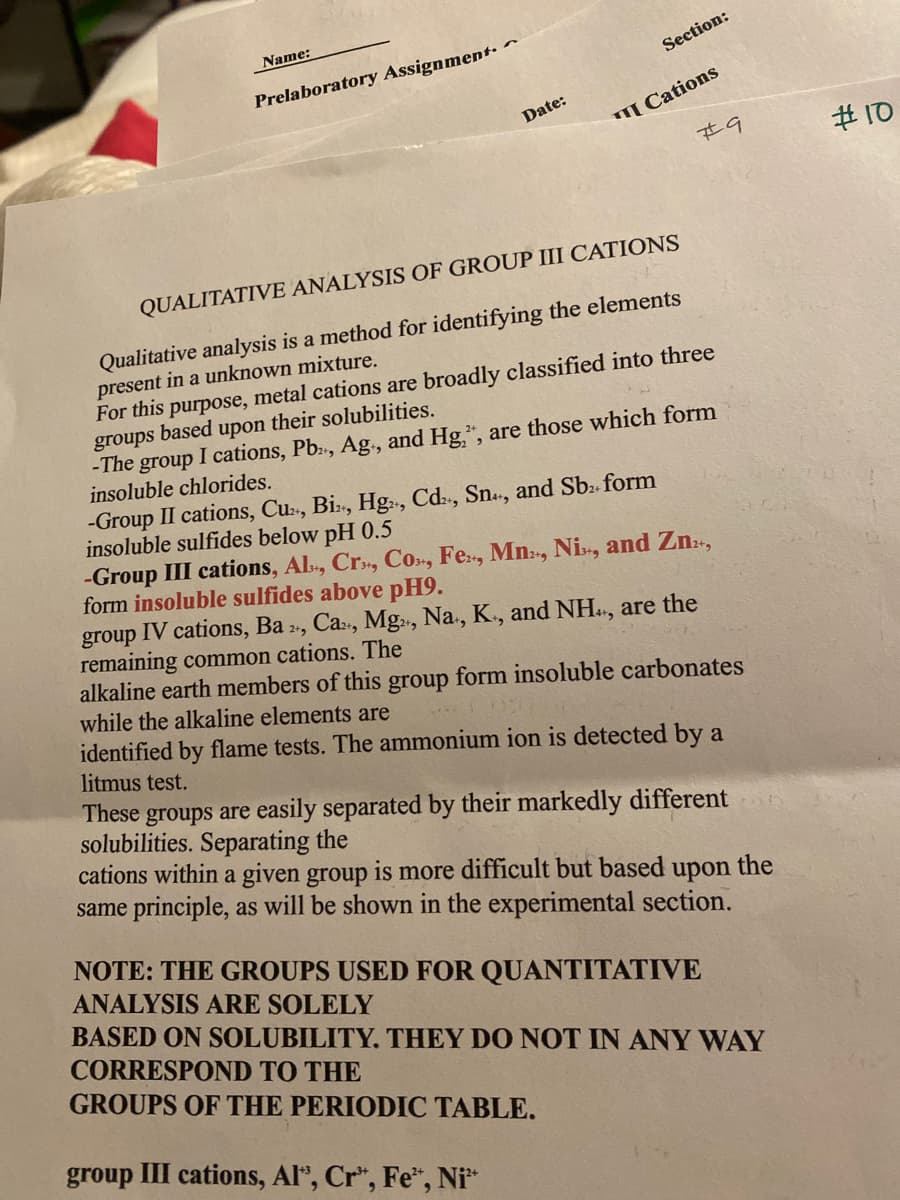Name: Date: Section: Prelaboratory Assignment: Qualitative Analysis Group III Cations 1. Prepare a complete flow chart for the procedure and put it on your data sheet.
Name: Date: Section: Prelaboratory Assignment: Qualitative Analysis Group III Cations 1. Prepare a complete flow chart for the procedure and put it on your data sheet.
World of Chemistry, 3rd edition
3rd Edition
ISBN:9781133109655
Author:Steven S. Zumdahl, Susan L. Zumdahl, Donald J. DeCoste
Publisher:Steven S. Zumdahl, Susan L. Zumdahl, Donald J. DeCoste
Chapter15: Solutions
Section: Chapter Questions
Problem 63A
Related questions
Question

Transcribed Image Text:n
Name:
Prelaboratory Assignment:
Name:
Date:
Section:
Prelaboratory Assignment: Qualitative Analysis Group III Cations
1. Prepare a complete flow chart for the procedure and put it on your data sheet.
#10

Transcribed Image Text:Section:
Cations
#9
Name:
.
Prelaboratory Assignment.
Date:
QUALITATIVE ANALYSIS OF GROUP III CATIONS
Qualitative analysis is a method for identifying the elements
present in a unknown mixture.
For this purpose, metal cations are broadly classified into three
groups based upon their solubilities.
-The group I cations, Pb2+, Ag+, and Hg, are those which form
insoluble chlorides.
-Group II cations, Cu2+, Bi, Hg2+, Cd2+, Sn4+, and Sb2+ form
insoluble sulfides below pH 0.5
-Group III cations, Al, Cr, Co, Fe, Mn, Ni, and Zn²+,
form insoluble sulfides above pH9.
group IV cations, Ba 2+, Ca2+, Mg2+, Na+, K+, and NH4+, are the
remaining common cations. The
alkaline earth members of this group form insoluble carbonates
while the alkaline elements are
identified by flame tests. The ammonium ion is detected by a
litmus test.
These groups are easily separated by their markedly different
solubilities. Separating the
cations within a given group is more difficult but based upon the
same principle, as will be shown in the experimental section.
NOTE: THE GROUPS USED FOR QUANTITATIVE
ANALYSIS ARE SOLELY
BASED ON SOLUBILITY. THEY DO NOT IN ANY WAY
CORRESPOND TO THE
GROUPS OF THE PERIODIC TABLE.
group III cations, Al*, Cr", Fe, Ni²+
#10
Expert Solution
This question has been solved!
Explore an expertly crafted, step-by-step solution for a thorough understanding of key concepts.
This is a popular solution!
Trending now
This is a popular solution!
Step by step
Solved in 2 steps with 1 images

Knowledge Booster
Learn more about
Need a deep-dive on the concept behind this application? Look no further. Learn more about this topic, chemistry and related others by exploring similar questions and additional content below.Recommended textbooks for you

World of Chemistry, 3rd edition
Chemistry
ISBN:
9781133109655
Author:
Steven S. Zumdahl, Susan L. Zumdahl, Donald J. DeCoste
Publisher:
Brooks / Cole / Cengage Learning

Chemistry: Principles and Practice
Chemistry
ISBN:
9780534420123
Author:
Daniel L. Reger, Scott R. Goode, David W. Ball, Edward Mercer
Publisher:
Cengage Learning

Introductory Chemistry: A Foundation
Chemistry
ISBN:
9781337399425
Author:
Steven S. Zumdahl, Donald J. DeCoste
Publisher:
Cengage Learning

World of Chemistry, 3rd edition
Chemistry
ISBN:
9781133109655
Author:
Steven S. Zumdahl, Susan L. Zumdahl, Donald J. DeCoste
Publisher:
Brooks / Cole / Cengage Learning

Chemistry: Principles and Practice
Chemistry
ISBN:
9780534420123
Author:
Daniel L. Reger, Scott R. Goode, David W. Ball, Edward Mercer
Publisher:
Cengage Learning

Introductory Chemistry: A Foundation
Chemistry
ISBN:
9781337399425
Author:
Steven S. Zumdahl, Donald J. DeCoste
Publisher:
Cengage Learning

Chemistry
Chemistry
ISBN:
9781305957404
Author:
Steven S. Zumdahl, Susan A. Zumdahl, Donald J. DeCoste
Publisher:
Cengage Learning

Chemistry: An Atoms First Approach
Chemistry
ISBN:
9781305079243
Author:
Steven S. Zumdahl, Susan A. Zumdahl
Publisher:
Cengage Learning
